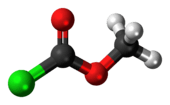Methyl chloroformate
 | |
 | |
| Names | |
|---|---|
| IUPAC name
Methyl carbonochloridate | |
| Other names
Methyl chloroformate, Chlorocarbonic methyl ester, Methyl chlorocarbonate | |
| Identifiers | |
| 79-22-1 | |
| 3D model (Jmol) | Interactive image Interactive image |
| 605437 | |
| ChemSpider | 6337 |
| ECHA InfoCard | 100.001.080 |
| EC Number | 201-187-3 |
| PubChem | 6586 |
| |
| |
| Properties | |
| C2H3ClO2 | |
| Molar mass | 94.49 g·mol−1 |
| Density | 1.223 g/mL |
| Boiling point | 70 to 72 °C (158 to 162 °F; 343 to 345 K) |
| Hazards | |
| EU classification (DSD) |
|
| R-phrases | R34 R50/53 |
| S-phrases | (S1/2) S26 S45 S60 S61 |
| Flash point | 10 °C (50 °F; 283 K) |
| Except where otherwise noted, data are given for materials in their standard state (at 25 °C [77 °F], 100 kPa). | |
| | |
| Infobox references | |
Methyl chloroformate is the methyl ester of chloroformic acid and is an oily liquid with a color that is anywhere from yellow to colorless. It is also known for its pungent odor.
Uses
Methyl chloroformate is used in organic synthesis for the introduction of the methoxycarbonyl functionality to a suitable nucleophile (i.e. carbomethoxylation).[2]
Safety
Methyl chloroformate, if heated, releases phosgene and produces toxic, corrosive fumes if it comes in contact with water.
See also
References
- ↑ Methyl chloroformate at Sigma-Aldrich
- ↑ Fischer, Emil (1914). "Synthesis of depsides, lichen-substances and tannins". Journal of the American Chemical Society. 36 (6): 1170–1201. doi:10.1021/ja02183a009.
This article is issued from Wikipedia - version of the 2/4/2016. The text is available under the Creative Commons Attribution/Share Alike but additional terms may apply for the media files.